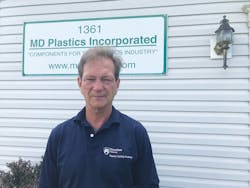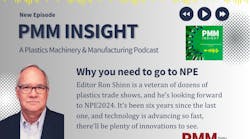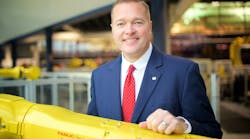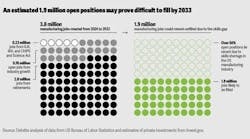By Bruce Adams
Michael Durina had his mind set on working in the plastics industry soon after he enrolled in the plastics engineering program at Ferris State University more than 40 years ago. Since then, he has held several positions in the industry, including a 16-year stint at Spirex Corp. where he was the VP of sales and marketing. He became an entrepreneur in 1999 when he launched Md Plastics Inc., which designs, engineers, manufactures and markets plasticating units. He is known for his innovative designs for screws and injection units and has licensed his company’s technology with manufacturers of injection molding machines and 3-D printers. He recently shared his thoughts with Plastics Machinery Magazine senior reporter Bruce Adams.
How did you end up in plastics engineering?
Durina: I went to Ferris [State University] wanting to get into heavy equipment technology, sat down with a guidance counselor who told me it was going to cost about three grand worth of tools and equipment, and I’d have a one-year waiting period. I asked, “What else have you got?” It’s a big technical school so I met with Frank Justin, who was the head instructor of their plastics program. He reminded me of my grandfather, because he was a gentleman and a scholar. I decided this is for me. We had three instructors, and there were 21 kids in our graduating class. It was an associate degree, so I had to go elsewhere to get my Bachelor of Science degree.
What were your first jobs in the plastics industry?
Durina: While at Ferris, I did a co-op in the Youngstown, Ohio, area at Dico Plastics in 1977. At Dico Plastics, we pulled a lot of polystyrene and polypropylene, but we also did core cavity changes on our molds. We had a lot of what I call family molds, and we would tear the molds down, and I was on the table helping them do that, loading hoppers and running them.
When I graduated, I worked 21 days on, two days off in the afternoon shift. I did that for a year. Then, I went to work for a company called Integrity Molding in Aurora, Ohio. We had six machines and three of us did the plumbing and hooked up all the machines and ran the air compressors. I worked there for a couple years, became the daytime manager, and then I went to work at Ethyl Products Nymold in Garrettsville, Ohio. We had 40-some molding machines and our primary business was making battery seals for Eveready.
They also had some automotive work that I ran in an assembly area with six or seven molding machines and a slew of pneumatic assembly machines. I worked in a toolroom, and I was the liaison between the plant and the toolroom.
Tell me about your time at Spirex.
Durina: I was at Spirex for 16 years. We had 18 employees when I started and 120 when I left. We went from $1.8 million in sales to about $22 million.
I ran the lab for 10 years and, as the business got bigger, we built a new lab.
That was back in the day when screw technology and plasticating units were in vogue, so to speak. There were some very good engineers and designers at the time.
Every resin manufacturer had a lab, and they had people in their lab who knew how to process. Young engineers had to go through training to learn how to process. Screw technology was very important, and it still is today, but people tend to pooh-pooh it. I think they’re pretty much ignorant today of the subject.
What did you learn at Spirex that helped you take your next career step?
Durina: We were very good at designing, developing and explaining the benefits of the equipment. We were innovative. We designed screws and screw tips. I personally had a pretty good run of what I thought were innovative products at the time.
I designed a screw tip with an automatic shutoff that had a thrust bearing in the back and a spring that pulled the poppet to shut it off. This was patented, and Xaloy is still selling these valves in the industry. It is called the Auto Shut. I designed a barrel attachment instead of an end cap that’s bolted on. I made this device that moved in and locked in place. All you needed was one little bolt to hold it in place. It was cool.
After I was the lab manager, I was the sales manager and then the vice president of sales and marketing. I took it upon myself to read just about every manual or every book or anything I could find that had something to do with plasticating screw technology and processing in general. I learned my trade that way.
I visited at least 3,000 plants in my career. You hear what everybody’s concerns are, and that prompts development and ideas and creativity and innovation to come up with better ways to do things.
Why did you leave Spirex and start your own company?
Durina: There was a management change at Spirex. The owner let his son run the company instead of promoting either myself or one of the other vice presidents. That didn’t go over too well, so I left. Over the years, I’d gotten job offers from most of the companies that we competed against, but I decided to go out on my own. I left Spirex in November 1999 and bought a little machine shop called McNeil Machine Parts in Columbiana, Ohio, and started from scratch. Soon after I started, I bought three older Toshiba molding machines that barely fit in my shop, so I sold two of them and kept one. I still have that machine here as my product development machine. Since my co-op in 1977, I’ve had a molding machine by my side.
When you started Md Plastics, what was your vision for the business?
Durina: I felt there was room to grow and that my skill and expertise were valuable. I was right. I mean, we didn’t grow that fast here, but mostly because of what I was doing. I actually started another company called Plastic Processing Technology in 2006. I ran around China for 10 years chasing the thousands and thousands of machines that were being built over there. I learned a lot, but I still felt I thought there was the ability to build a national business and fortunately, I had the ability to invent some new products, and that’s helped us along the way. I’ve never looked back.
Discuss your screw and screw tip technology.
Durina: A number of years ago, we invented the world’s smallest shut-off nozzle tip called the Mini-Shut. That technology is cool. There's a poppet, Belleville spring washers for force, body and a seat. It opens on pressure and closes, and the poppet centers itself inside the body of the nozzle tip, so it only takes five minutes to put on and five minutes to take off. It prevents stringing, straining and drooling. We’ve sold thousands of those in the last couple of years.
Last year, we applied for a patent on a new injection unit called the Inject-Ex. Our design has a stationary screw. We want to replace the reciprocating screw with a design that has a stationary screw, but it can move in and out. We have a hopper that’s fixed to a barrel. Inside the barrel is a screw, the screw is in a fixed position with the hopper. The end of that assembly is a plunger head and inside the plunger head utilizes our Mini-Shut technology. The screw rotates, conveys plastic, moves it down and pumps it through the plunger head that’s attached to the inner barrel, and that whole assembly sits inside of a pressure vessel. So, now that whole assembly moves in and out, reciprocates back and forth. But the screw is stationary, so it has much better melt quality. Every pellet sees the same shear history and heat history. The plunger head shuts off instantly.
Now we’re out there trying to tell the OEMs that we have something better than what they’ve been using for the last 70 years. It’s going to take a little while.
What are you working on now?
Durina: We have a product called the Melt Profiler system that monitors polymer melt. It measures melt temperature in real time and calculates a power factor that can be used to predict and document part quality. We’ve been working on that with a melt-sensing technology that we are going to call the Melt-IQ system. We have a sensor that is industrial-grade, it’s very sensitive and you can put it into the melt stream of the nozzle and the end cap, forward of the shut-off point. We take that melt temperature and it’s very dynamic, and we can extrapolate the rise in that temperature with the mass and determine how many calories we used or the amount of work that the machine put into the plastic. So, we can determine good and bad part production right through the nozzle. We are using scientific molding principles and making the machine smarter. We don’t need to have sensors put into a mold to tell us whether we made a good or bad part.
We’re building our own embedded board, a circuit board, that has a microprocessor on it and an analog digital converter that reads the data faster than a molding machine’s processor, which is typically 1 kilosample per second. We put this into learning mode and learn the work that was applied to the plastic during the fill-stage interval in the blank fill. Because we can read it faster than the machine’s processor can process, we will be able to direct the machine velocity pressure transfer points right through our technology.
We have gone from plasticating screw technology to the hardware business to now where we want to build our own molding machine and sell our IP technology to machine builders around the world to help their machine become smarter.
We also have a new Inject-Ex injection unit. One OEM, Windsor Machines in India, is building one and they hope to replace three different length and different size injection units with one Inject-Ex. It will have the same or greater velocity, the same or greater output capacity and the same or greater pressure. Every pellet will be exposed to a stationary screw.
What are some of the most important milestones for Md Plastics?
Durina: Our ideas and our patents that have helped us grow. The first one was the Posi-Melt screw technology. Then we had the MDP screw tip and the invention of the Mini-Shut. Now we have the Inject-Ex patent. We shift our ideas and resources and focus. That makes things fun. I can’t see doing the same product for 20 years. It doesn’t make sense to me. With that mindset, everything that is built today will stay the same, and that’s just not true. We want to have new ideas and be innovative.
For example, our goal is to take our new Inject-Ex in and couple it with our new Melt Sensor and Melt Profiler and mold parts that are perfect, and/or tell you they are not. If we can do that, we don’t need as much human interaction in terms of quality control.
Tell me about your extruder assembly for 3-D printing.
Durina: About four years ago I was contacted by a company called Hapco that sells glue guns used in roofing. They wanted me to build a better extruder that could be used in additive manufacturing. Hapco found me through a company called Strangpresse LLC, which makes extruders and accessories for additive manufacturing. I designed the Model 19 with a 19mm screw that produces about 50 pounds an hour. Then we designed a Model 30 that produces 150 pounds an hour. We built a Model 14 that is on a machine that a company called JuggerBot 3D is selling. They are located in Youngstown, Ohio.
A company called Thermwood in Dale, Ind., builds the best machine in the world for 3-D printing. They had problems with a big extruder they bought. I showed them what we did with our Model 30, and they bought our Model 30 and then they bought a couple more. We ended up in a license agreement with them.
AutoDesk bought a couple of our [extruders for] 3-D printers and used it in NASA’s 3D-Printed Habitat Challenge. It was our printer that built that Mars habitat. We are proud of what we did in that space.
Why is pellet-fed 3-D printing better than filament-fed?
Durina: Pellet-fed is 30 to 100 times faster than filament-fed 3-D printers. It is a unique screw design. It is more like what an injection screw would do more than what an extruder screw would do. An extruder screw is built for a certain type of output with a certain amount of shear and has a fixed and narrow range of RPMs. The additive printer is quite different. It can be running at 2 RPMs one minute and 150 RPMs the next minute.
What problems do you see with reciprocating-screw technology?
Durina: An Engel article several years ago about the extreme precision of an injection molding machine puts things in perspective. The precision is such that they can make the screw back up to a set position and move forward to a set position within virtually millionths of an inch. But despite that, people make bad parts every day. What is the cause? The article mentioned three things, but it is actually four things: Viscosity variation due in part to poor melt homogenization; variation in the amount of polymer downstream of the NRV due to constant pressure flow changes and decompression inconsistencies; variation in the quantity of melt displaced due to inconsistent NRV closure; and variation in the quantity of melt displaced due to poor control of the shut-off points. If you look at those four criteria, you can find the fault of the reciprocating screw.
If you look at the homogenization side, the first pellet is fed to the plasticating screw, is conveyed forward along the axis of the screw, is melted and pumped through a check valve, displaces volume in front of the check valve, and the screw starts to back up. As it backs up, every subsequent pellet sees a different heat history and a different residence time than the first pellet. All these pellets are seeing variations in heat and residence time. They are not homogenized. The bigger the shot, the less homogeneity you experience. If the world continues to use the reciprocating screw and general-purpose screws, it’s never going to get any better. The process where the screw backs up, leads to a non-homogenous melt pool.
While the screw backs up, its relationship to the feed housing changes and the flights are not being fed pellets. The larger the shot, the more channel volume is void of pellets until the screw moves forward during injection, then the pellets fill the flight channels via gravity, but the channels are not completely full and the pellets are not compacted. This phenomenon is called "solids bed compaction." The end result is a pause in recovery rate, extra shear and retarded recovery time. It is the pressure that you build in the feed section and the advancing of the solid pellets that make everything happen. While that screw is sitting there waiting for this compaction to catch up again, the screw just spins, and that is unpredictable.
Then you have some variation of a check valve that sits in front of the screw. Whatever type of design you use, unless there is some type of mechanical action to open and close it, which 99 percent of the machines in use don’t have, you will have variation across the shut-off plane. Variation means that even when the screw backs up and is just sitting there, changes are being made because we are applying heat to the plastic. We are always changing the state of the plastic or the viscosity of the plastic.
It’s a process that is a detriment to part quality, but it is basically a necessity right now. When you compile those problems, at least from the plasticating unit from the machine side, that’s why you have variation and that’s why we make bad parts. From the machine's point of view, that’s what the reciprocating screw’s deficiencies are.
How could those problems with reciprocating screw technology be solved?
Durina: We address that with the Inject-Ex technology. We have a stationary screw relative to the hopper and the feed pocket of the barrel are fixed with each other. That does not reciprocate, that does not change. Once you rotate the screw, every pellet, regardless of the shot size, has to traverse along the axis of that screw, has to build pressure and open up a plunger head that is attached to the end of the barrel. We are using the kinetic energy of the spring washers in the plunger head to create some head pressure or resistance of flow, which is good for the plastic melt, and it also supplies the force necessary to have instantaneous shutoff. So, the plastic flows through the plunger head, which is fixed in tight proximity to the pressure vessel and displaces volume up front and the whole assembly backs up.
Our Inject-Ex assembly is like a little syringe. The syringe moves in and out, and that is how we control the melt quality and the homogenization. Every pellet sees the same shear history and heat history regardless of the shot size. There is instantaneous shutoff across the shut-off point, it’s very discrete, precise and consistent.
We can control the amount of work that is put in there by changing the force on the Belleville spring washers. That is a discrete and instantaneous shutoff. We can actually see and measure the mass that is in front of the shut-off point, which is unique. We have separated the melting chamber and the melt pool. On a reciprocating screw, that doesn’t happen. We are doing all this on one axis, which is extremely important and a key claim on our patent. It is unique and makes the unit less expensive. It is better for the plastic itself in terms of residence time, and it’s easy to clean. We sold a number of these units, and a couple have been running for more than a year. I have one set up on my injection molding machine. I have it retrofitted with the RJG unit, so that we can essentially use a third-party component to verify and compare our technology.
Does the industry need standards for screw development?
Durina: The industry needs to develop a world-standard general-purpose screw. If we had a world standard and a method for evaluation, then we take the mystery out of what a screw can do in terms of what level of homogenization you can get and what kind of viscosity you can achieve with that general-purpose screw. If we develop a standard and a method for evaluation, we can put the viscosity data and screw recovery data on somebody’s database, say Euromap or the Plastics Industry Association, and then that data can be used to accommodate mold-flow analysis. Mold flow guys today are making decisions using garbage. They are using the information that comes from a rheometer that has nothing to do with what an injection unit can perform on any injection molding machine. They are making all kinds of assumptions when they design a mold, based on viscosity data from a rheometer.
What will be the next phase of machine automation in injection molding or extrusion?
Durina: Small cavitation, small shots, mobile injection units, Industry 4.0 with the right sensors. Use sensors to help control the position of the machine. On big molds, find a way to keep these two halves of the mold together, but instead of shooting one big shot in the center, why not hook up multiple little injectors and position them around the mold? Use those injectors like they are using valve gating and hot screw technologies. Put that mold on the floor and clamp it together quick and put five or 10 little injectors on it and inject that way. Forget about these gigantic machines with big, massive steel.
I see smaller cavitation, smaller quick machines, mobile machines on assembly lines. Conformal cooling is a very cool technology.
Do you have any hobbies?
Durina: I like to compete at just about anything. I play a lot of golf, or as much as I can fit in. I designed and 3-D printed my own putter.
How would you like to be remembered? What legacy do you want to leave behind?
Durina: I still have something to prove, but I’d like to be recognized as a thought leader in the industry. Somebody who had some good ideas and implemented them and had an impact on people. I try to influence people in a positive way. No. 2, as somebody who liked to compete. That’s important in my personal life.
Just the facts
Who is he: Michael Durina, president and owner of Md Plastics Inc.
Headquarters: Columbiana, Ohio
Founded: 1999
Employees: Nine
Age: 65
Education: Bachelor of Science in industrial engineering from Kent State University






